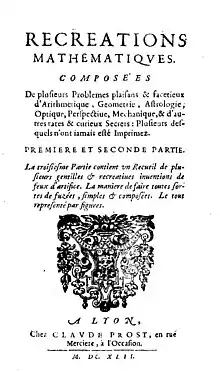Jean Leurechon
Jean Leurechon (c. 1591 – 17 January 1670) was a French Jesuit priest, astronomer, and mathematician, known for inventing the pigeonhole principle and naming the thermometer.

Life
Leurechon was born in Bar-le-Duc where his father, also named Jean Leurechon, was a physician to the Duke of Lorraine.[1] He sent Leurechon to be educated at the Jesuit university in Pont-à-Mousson but, learning of Leurechon's desire to take holy orders[2] and wishing him instead to become a physician,[1] brought him back to Bar-le-Duc.[2] In 1609 Leurechon ran away from home to return to the Jesuits,[2][3] and the story goes that this so enraged his mother that she took up a dagger and attempted to assassinate the head of the local Jesuit order.[3] His father appealed to the parliament in Paris, which had jurisdiction over Pont-à-Mousson, and Leurechon was returned again to Bar-le-Duc, where the Duke ordered Leurechon to be held at the convent of the Minims in Nancy.[3][2] This did not change his resolve, and after a month his parents let him go.[3]
Leurechon taught mathematics from 1614 to 1629 at Pont-à-Mousson,[4] and in 1631 became rector of the Collège Gilles de Trèves, a Jesuit school in Bar-le-Duc.[1][3] This position reconciled him with his parents, who willed their estate to the Jesuits.[3] At Bar-le-Duc, he also took the confessions of Charles IV, Duke of Lorraine.[2]
From 1649 to 1655 he worked in an army chapel in Brussels.[5] He died on 17 January 1670 in Pont-à-Mousson.[2]
Works
After two earlier works on astronomy,[6] in 1619 Leurechon published two works on a comet that became visible in November and December of 1618.[7] In 1622 he published the book Selectæ Propositiones in Tota Sparsim Mathematica Pulcherrimæ.[4] Another book, Récréations Mathématiques, concerning recreational mathematics, was published in 1624 at Pont-à-Mousson under the name H. van Etten, described in the dedication of the book as a student at Pont-à-Mousson. It has been commonly attributed to Leurechon, and the van Etten name interpreted either as a pseudonym or as a "modest" misattribution, but this has been disputed by some scholars, who argue that an actual student named van Etten was the author.[4][5][8][9] It was republished in many later editions.[5]
The 1622 book contained a brief reference to the pigeonhole principle, much earlier than its common attribution to Peter Gustav Lejeune Dirichlet in 1834, and the 1624 book spelled out the principle in more detail.[4] The 1624 book also contained the first use of the word "thermometer", replacing an earlier word "thermoscope" for the same device.[9][10]
References
- Mémoires de la Société des lettres, sciences et arts de Bar-le-Duc (in French), 1901, pp. 271–272
- Fouqeray, Henri, SJ (1922), Histoire de la Compagnie de Jésus en France : des origines à la suppression, (1528–1762), Vol. III: Époque de Progrés (1604–1623), Bureaux des Études, p. 277
- Padberg, John W., SJ (November 2000), "Of all things...", Studies in the Spirituality of Jesuites, 32 (5): iii–iv
- Rittaud, Benoît; Heeffer, Albrecht (2014), "The pigeonhole principle, two centuries before Dirichlet", The Mathematical Intelligencer, 36 (2): 27–29, doi:10.1007/s00283-013-9389-1, hdl:1854/LU-4115264, MR 3207654, S2CID 44193229
- Heeffer, Albrecht (2006), "Récréations Mathématiques (1624) A Study on its Authorship, Sources and Influence" (PDF), Gibeciere, 1: 77–167
- "Jean Leurechon". Encyclopedia.com. Retrieved 2020-01-27.
- Romano, Antonella (1999), La Contre-Réforme Mathématique: Constitution et diffusion d'une culture mathématique jésuite à la Renaissance (1540-1640), Bibliothèque des Écoles françaises d'Athènes et de Rome, p. 521
- Hall, Trevor H. (1973), Old conjuring books: a bibliographical and historical study with a supplementary check-list, St. Martin's Press, pp. 101, 116–117
- Borrelli, Arianna (2008), "The Weatherglass And Its Observers In The Early Seventeenth Century", in Zittel, Claus; Nanni, Romano; Engel, Gisela; Karafyllis, Nicole (eds.), Philosophies of Technology: Francis Bacon and his Contemporaries, Intersections: Interdisciplinary Studies in Early Modern Culture, 11, Brill, pp. 67–130, doi:10.1163/ej.9789004170506.i-582.24, ISBN 978-90-47-44231-8. See in particular The Thermometer as a Mathematical Instrument, pp. 119–122.
- Fretwell, Mattie Bell (February 1937), "The Development of the Thermometer", The Mathematics Teacher, 30 (2): 80–83, doi:10.5951/MT.30.2.0080, JSTOR 27952013